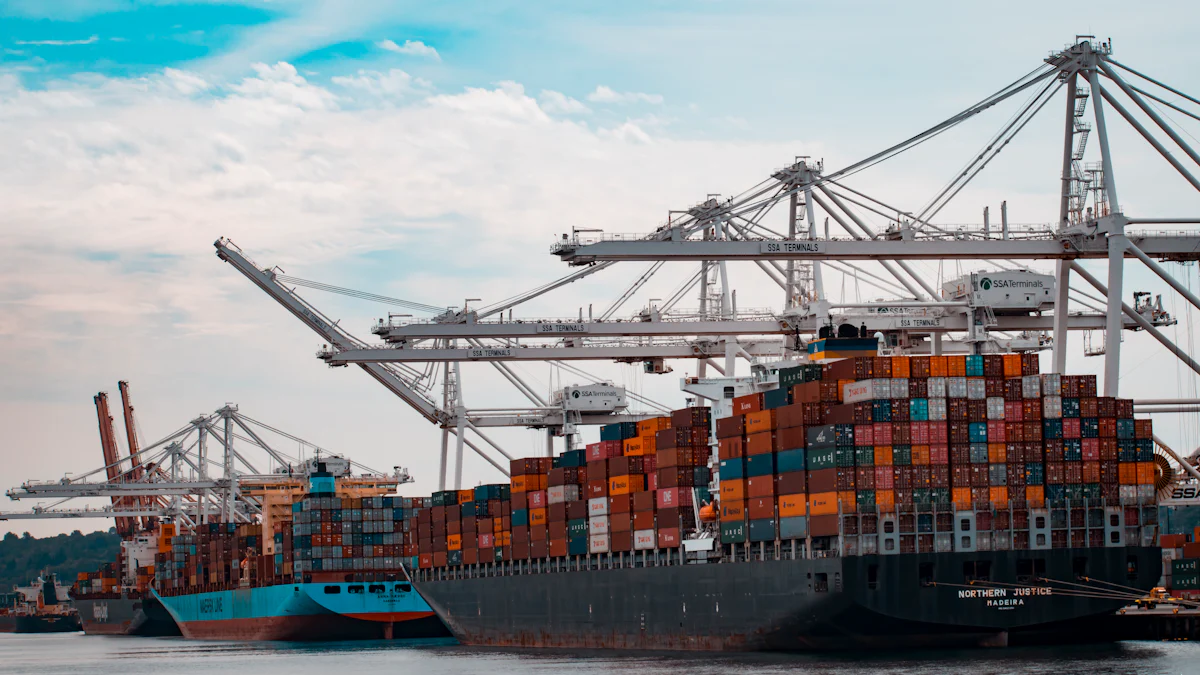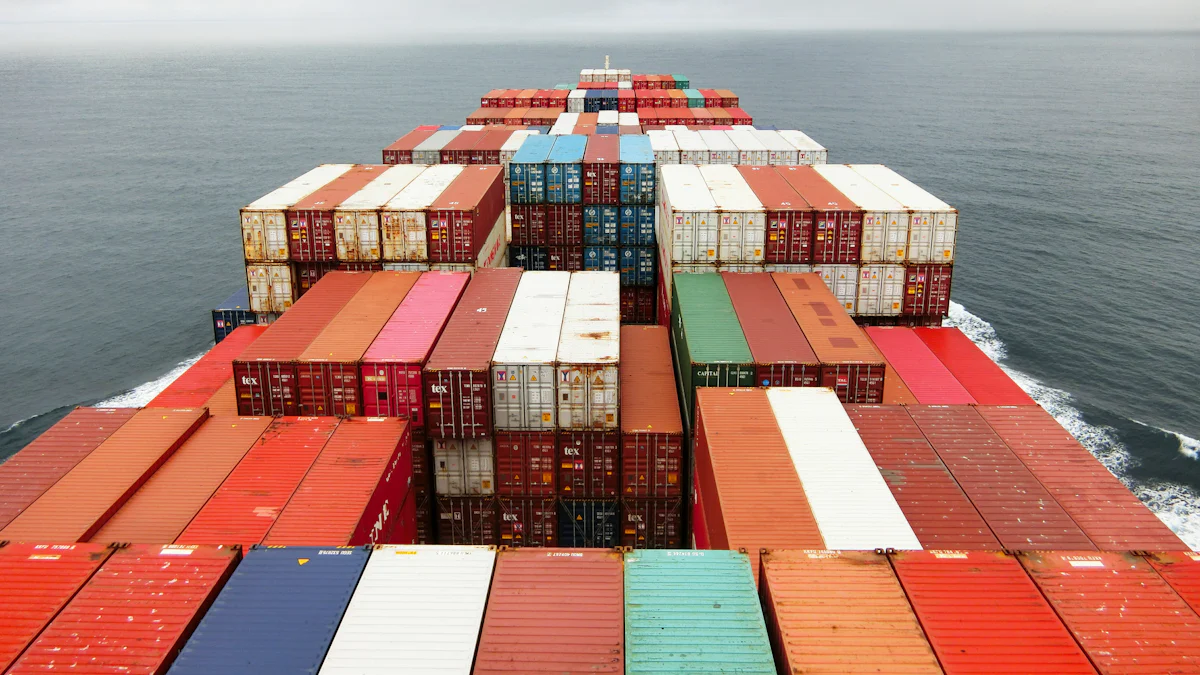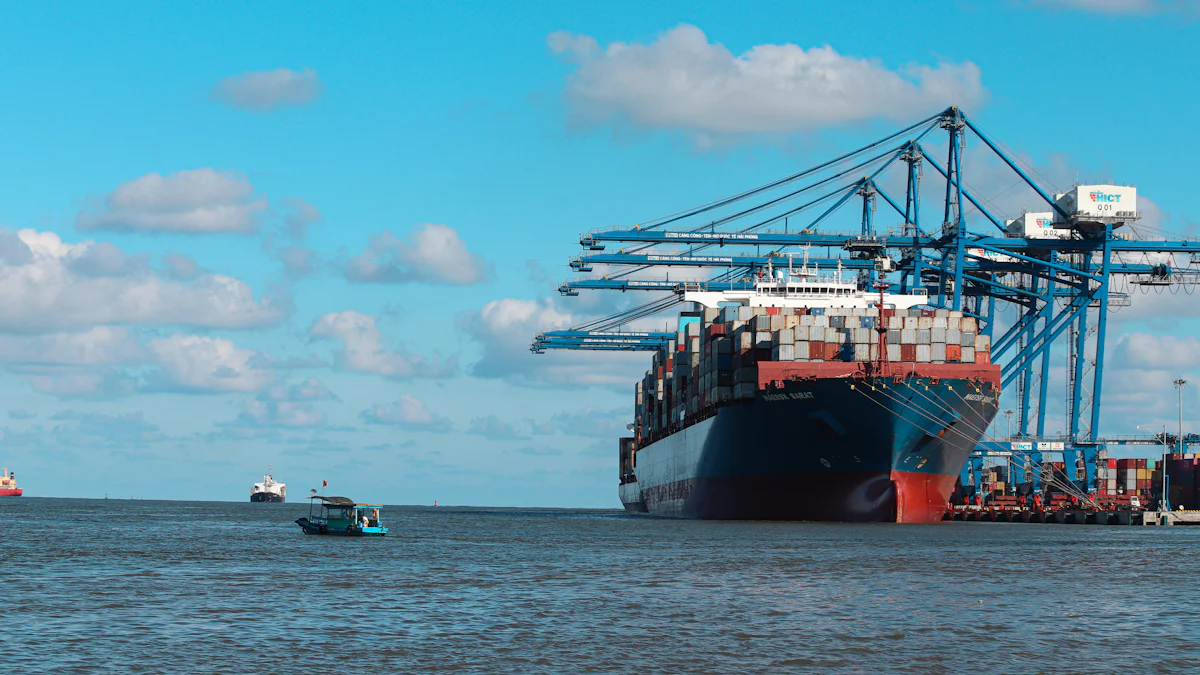Everything You Need to Know About Logistics Freight

Logistics freight plays a pivotal role in global trade, facilitating the movement of goods across vast distances efficiently. The significance of logistics freight is underscored by its contribution to the seamless exchange of products worldwide. This blog delves into the intricate workings of logistics freight, shedding light on its complexities and nuances to empower professionals in navigating this dynamic industry.
Understanding Logistics Freight
Basic Concepts
The inception of logistics freight revolves around the fundamental understanding of its definition and scope. This entails grasping the essence of how goods are efficiently transported across various distances, emphasizing the pivotal role it plays in global trade. Key terminology associated with logistics freight encompasses a specialized lexicon that professionals navigate to ensure seamless operations.
Historical Background
Delving into the historical backdrop unveils a rich tapestry of evolution within logistics freight. The emergence of automobiles in the early 20th century catalyzed advancements in transportation, leading to the development of trucks and commercial vehicles for enhanced mobility. Furthermore, significant milestones like the introduction of container ships revolutionized freight logistics by lowering transport charges and fostering globalization. The Industrial Revolution marked a pivotal era with the advent of railways and steamships, expanding transportation reach and efficiency.
Types of Logistics Freight

Modes of Transportation
Road Freight
When considering logistics freight options, road transport emerges as a versatile and widely utilized mode. It offers flexibility in reaching diverse locations, making it suitable for various goods. The choice of road freight depends on factors like product size, distance traveled, and delivery timelines. This mode ensures direct point-to-point delivery, enhancing efficiency in the supply chain.
Rail Freight
In the realm of logistics freight, rail transport stands out as an efficient and cost-effective option for shipping goods over long distances. Despite being less understood among shippers, rail transport plays a crucial role in specific industries due to its reliability and capacity for bulk cargo. Understanding the basics of rail shipping is essential for optimizing logistics processes effectively.
Air Freight
For expedited deliveries and time-sensitive shipments, air freight serves as a rapid and reliable choice in logistics freight. This mode guarantees swift transportation globally, especially for high-value or perishable goods requiring quick delivery. Leveraging air transport optimizes transit times and ensures timely deliveries to meet customer demands efficiently.
Sea Freight
Navigating international waters, sea freight offers a cost-efficient solution for transporting large volumes of goods across long distances. With multiple maritime routes worldwide, sea freight provides extensive coverage for global trade operations. Understanding the intricacies of sea freight logistics is vital for businesses looking to optimize their shipping processes effectively.
Specialized Freight
Perishable Goods
When handling delicate products with limited shelf life, specialized logistics freight services cater to perishable goods' unique requirements. Maintaining temperature-controlled environments during transportation is crucial to preserve freshness and quality. Businesses must prioritize reliable carriers equipped with proper refrigeration facilities to ensure the safe delivery of perishable items.
Hazardous Materials
Transporting hazardous materials demands strict adherence to safety regulations and specialized handling procedures in logistics freight operations. Proper labeling, packaging, and documentation are essential to mitigate risks associated with hazardous cargo transportation. Choosing experienced carriers with expertise in handling dangerous goods ensures compliance with industry standards and minimizes potential hazards.
Oversized Cargo
Managing oversized cargo presents logistical challenges that require tailored solutions in logistics freight planning. Specialized equipment and expertise are necessary to handle large or heavy items efficiently during transportation. Coordinating with carriers equipped with the appropriate resources ensures secure loading, transit, and unloading processes for oversized cargo shipments.
The Logistics Freight Process

Planning and Coordination
Route Planning
Efficient logistics freight operations necessitate meticulous route planning to optimize delivery schedules and minimize transit times. By strategically mapping out the most direct and cost-effective paths, companies can enhance their supply chain efficiency and reduce operational costs significantly. Embracing advanced route planning technologies enables real-time adjustments to address unforeseen challenges, ensuring timely deliveries.
Scheduling
The scheduling aspect of logistics freight involves precise coordination of transport activities to streamline the movement of goods seamlessly. Establishing well-defined schedules for loading, unloading, and transit intervals enhances operational efficiency and customer satisfaction. Implementing automated scheduling systems fosters accuracy in time management, reducing delays and improving overall logistics performance.
Execution and Monitoring
Loading and Unloading
Loading and unloading procedures are critical stages in the logistics freight process that demand precision and efficiency. Proper handling techniques during loading prevent damage to goods while ensuring secure placement within transport vehicles. Equally important is the systematic unloading process upon arrival, guaranteeing swift offloading to expedite subsequent delivery stages.
Tracking and Monitoring
Real-time tracking and monitoring mechanisms play a pivotal role in modern logistics freight operations by providing visibility into shipment progress at every stage. Leveraging cutting-edge tracking technologies enables companies to monitor cargo movements, anticipate potential disruptions, and proactively address logistical challenges. Continuous monitoring ensures adherence to delivery timelines, enhances security measures, and fosters trust among stakeholders.
Delivery and Post-Delivery
Final Mile Delivery
The final mile delivery phase represents the last crucial leg of the logistics freight journey, directly impacting customer satisfaction levels. Efficiently navigating this stage requires optimized routing strategies for prompt deliveries while considering factors like traffic conditions and recipient availability. Prioritizing final mile logistics streamlines order fulfillment processes, reduces delivery lead times, and elevates overall service quality.
Customer Feedback and Returns
Gathering customer feedback post-delivery serves as a valuable tool for assessing service quality in logistics freight operations. Feedback insights enable companies to identify areas for improvement, refine service offerings, and enhance customer experiences. Additionally, establishing seamless return processes for unsatisfactory deliveries cultivates customer loyalty by showcasing responsiveness to concerns while maintaining service excellence standards.
Comparing Different Freight Options
Cost Analysis
Cost Factors
Ocean freight is often the most economical choice due to lower fuel costs.
Air freight, while more expensive, offers rapid delivery for time-sensitive shipments.
Rail freight proves cost-effective for transporting large volumes over extended distances efficiently.
Intermodal transport combines the strengths of rail and trucking, providing a versatile solution.
Truckload services offer flexibility in accommodating varying shipment sizes and destinations.
Less Than Truckload (LTL) shipping presents a budget-friendly alternative compared to full truckload services.
Expedited truck services prioritize speed but come at a higher cost.
Cost Comparison by Mode
Ocean Freight: Economical choice with lower fuel costs and ideal for transporting heavy or bulky goods over long distances.
Air Freight: Expensive option known for its speed in delivering high-value or perishable goods globally.
Rail Freight: Cost-effective mode suitable for transporting large volumes efficiently across extensive distances.
Intermodal Transport: Combines rail and trucking advantages, offering a balanced approach to logistics freight solutions.
Truckload Services: Flexible option catering to diverse shipment sizes and destinations with customizable features.
Less Than Truckload (LTL): Budget-friendly alternative for smaller shipments requiring cost-efficient transportation solutions.
Expedited Truck Services: Premium service prioritizing swift deliveries at a higher expense.
Speed and Efficiency
Transit Times
Ocean freight may have longer transit times due to maritime travel but provides cost-effective global shipping solutions.
Air freight ensures rapid deliveries, making it an optimal choice for time-sensitive shipments requiring quick turnaround times.
Rail freight offers efficient transportation over land routes, balancing speed with cost-effectiveness for long-distance hauls.
Reliability
Ocean Freight:
Reliability hinges on adherence to schedules despite longer transit times associated with sea travel.
Established maritime routes contribute to consistent service quality and reliability in global shipping operations.
Air Freight:
Known for its reliability in meeting tight delivery deadlines, especially crucial for perishable or high-value goods requiring expedited transport.
Rail Freight:
Demonstrates reliability in handling large cargo volumes over extended distances efficiently, ensuring timely deliveries within specified schedules.
Environmental Impact
Carbon Footprint
Sea Freight:
Sea freight's environmental impact is relatively lower due to its fuel efficiency when transporting heavy or bulky goods over long distances.
Air Freight:
Air freight contributes significantly to carbon emissions due to high fuel consumption during flights, impacting the environment adversely.
Rail Freight:
Rail transport boasts a lower carbon footprint compared to air transport, offering an eco-friendly solution for moving goods sustainably over land routes.
Sustainable Practices
Implementing sustainable practices in logistics operations is vital for reducing environmental impact and promoting eco-conscious initiatives within the industry:
Optimizing Routes: Efficient route planning minimizes fuel consumption and greenhouse gas emissions during transportation processes.
Utilizing Eco-Friendly Technologies: Adopting green technologies like electric vehicles or hybrid engines reduces carbon emissions while enhancing operational efficiency.
Emission Reduction Strategies: Implementing emission control measures such as regular maintenance checks on vehicles helps mitigate harmful pollutants released into the atmosphere.
Promoting Green Supply Chains: Collaborating with environmentally responsible partners fosters sustainability throughout the supply chain network, encouraging eco-friendly practices collectively.
Practical Advice for Logistics Freight
Choosing the Right Freight Option
Factors to Consider
Evaluate the nature of your cargo, considering its size, weight, and special handling requirements.
Analyze the distance and destination of your shipment to determine the most suitable mode of transportation.
Assess the urgency of delivery to select a freight option that aligns with your timeline and customer expectations.
Factor in cost considerations, including transportation fees, fuel expenses, and potential surcharges based on the chosen mode.
Decision-Making Tips
Prioritize reliability by choosing established carriers with a track record of on-time deliveries and secure handling practices.
Seek flexibility in freight options to accommodate unforeseen changes or fluctuations in shipment demands.
Embrace technology-driven solutions for real-time tracking and monitoring capabilities to enhance visibility and control over your cargo.
Collaborate with logistics experts or consult industry resources to stay informed about emerging trends and best practices in freight management.
Best Practices
Efficient Packing
Optimize packaging materials to ensure maximum protection for goods while minimizing excess weight or space utilization.
Utilize standardized container sizes or pallet configurations for streamlined loading processes and enhanced cargo security.
Implement labeling systems that clearly identify contents, handling instructions, and destination details for efficient sorting and distribution.
Documentation and Compliance
Maintain accurate records of shipments, including invoices, customs documentation, and regulatory permits to facilitate smooth transit across borders.
Stay informed about international trade regulations, import/export restrictions, and compliance standards to avoid delays or penalties during freight operations.
Partner with customs brokers or legal advisors to navigate complex documentation requirements and ensure adherence to legal frameworks.
Common Challenges and Solutions
Delays and Disruptions
Address potential delays proactively by identifying critical points in the supply chain where bottlenecks may occur.
Implement contingency plans for unexpected disruptions such as adverse weather conditions, port congestion, or labor strikes that could impact delivery schedules.
Risk Management
Conduct risk assessments to identify vulnerabilities in your freight operations related to security threats, theft incidents, or logistical breakdowns.
Invest in insurance coverage tailored to mitigate risks associated with cargo damage, loss, or liability issues during transit.
By incorporating these practical recommendations into your logistics freight strategies, you can optimize operational efficiency, minimize risks, and deliver superior service quality to meet evolving market demands effectively.
JUSDA's Comprehensive Logistics Freight Services
Road Freight
Network and Coverage
JUSDA has established robust networks with cross-border transfer centers, ensuring seamless connectivity for road freight operations.
The extensive coverage spans key regions in South China, East China, and from Wuhan to Beijing, offering comprehensive logistics solutions.
Cross-Border Services
Facilitating cross-border road freight services between China and ASEAN countries like Vietnam and Myanmar, JUSDA ensures efficient international cargo transfers.
Leveraging international logistic partnerships, JUSDA optimizes cross-border operations to provide accountable and reliable freight services.
Industry-Specific Solutions
Tailoring transport solutions for specialized industries such as new energy vehicles and broad electronics showcases JUSDA's commitment to addressing unique sector requirements.
With exceptional performance in large-scale and bulk cargo markets, JUSDA delivers industry-specific logistics solutions that enhance operational efficiency.
Ocean Freight
Global Shipping Services
Offering global shipping services to more than 500 destinations worldwide via over 2,500 international maritime routes underscores JUSDA's expansive reach.
The mature global ocean freight network ensures stable space allocation and reliable shipping services for diverse cargo requirements.
Value-Added Services
Providing value-added services such as temperature-controlled transportation enhances the quality of goods transported via ocean freight.
Specialized offerings like the Southeastern U.S. Special Line and Matson Express prioritize fast and competitive delivery options for customers.
Air Freight
Route Network
With a rich route network encompassing established routes like China-Mexico-US and Vietnam-US, JUSDA offers comprehensive air freight solutions.
Planned expansions into new routes like China-India demonstrate JUSDA's commitment to enhancing global connectivity through air transportation.
Customized Services
Utilizing a strong technological system powered by big data and AI tools enables JUSDA to design optimal integrated solutions tailored to customer needs.
By focusing on real-time collaboration platforms for supply chain management, JUSDA delivers intelligent decision-making capabilities that improve efficiency across air freight operations.
Rail Freight
China-Europe Block Trains
China-Europe Block Trains represent a strategic logistics solution that streamlines the transportation of goods between these key regions. By leveraging dedicated train services, companies benefit from efficient cross-continental connectivity, reducing transit times and enhancing supply chain reliability. The seamless integration of rail freight operations ensures cost-effective and timely deliveries, catering to the growing demands of global trade.
Multimodal Transport
Embracing multimodal transport solutions optimizes logistics efficiency by combining various modes of transportation seamlessly. JUSDA's expertise in multimodal transport enables the integration of rail freight with other modes like road, air, and sea, offering comprehensive end-to-end solutions for diverse cargo requirements. This approach enhances flexibility in routing options, mitigates logistical challenges, and maximizes operational synergies to deliver superior service quality across international supply chains.
Summarize the intricate workings of logistics freight, emphasizing its pivotal role in global trade.
Highlight the significance of informed decision-making in selecting optimal freight options for efficient supply chain management.
Encourage professionals to leverage the insights and advice provided to enhance their logistics operations effectively.
See Also
Benefits of Participating in Leading Logistics Webinars
Revealing the Definitive Global Logistics Companies Guide
2024 Sea Freight Logistics Innovations Uncovered
